Evaluation of Three Peptide Immobilization Techniques on a QCM Surface Related to Acetaldehyde Responses in the Gas Phase
Abstract
1. Introduction
2. Materials and Methods
2.1. Peptide Synthesis
2.2. Method for Prefabrication of QCM-Based Biosensor
2.3. Peptide Deposition Methods on QCM Crystals
2.3.1. Drop-Casting Method
2.3.2. Spin Coating Method
2.3.3. Dip Coating Method
2.4. Measurement Setup and Gas Chamber
3. Results and Discussion
3.1. Evaluation of Deposition
3.2. Peptide-Based Sensor Film Characterization
3.3. Peptide-Based Sensors Responses to Odorants
4. Discussion and Conclusions
Author Contributions
Conflicts of Interest
References
- Wasilewski, T.; Jacek, G.; Kamysz, W. Bioelectronic nose: Current status and perspectives. Biosens. Bioelectron. 2017, 87, 480–494. [Google Scholar] [CrossRef] [PubMed]
- Cave, J.W.; Wickiser, J.K.; Mitropoulos, A.N. Progress in the development of olfactory-based bioelectronic chemosensors. Biosens. Bioelectron. 2018, 123, 211–222. [Google Scholar] [CrossRef] [PubMed]
- Del Carlo, M.; Fusella, G.C.; Pepe, A.; Sergi, M.; Di Martino, M.; Mascini, M.; Martino, G.; Cichelli, A.; Di Natale, C.; Compagnone, D. Novel oligopeptides based e-nose for food quality control: Application to extra-virgin olive samples. Qual. Assur. Saf. Crop Foods 2014, 6, 309–317. [Google Scholar] [CrossRef]
- Compagnone, D.; Faieta, M.; Pizzoni, D.; Di Natale, C.; Paolesse, R.; Van Caelenberg, T.; Beheydt, B.; Pittia, P. Quartz crystal microbalance gas sensor arrays for the quality control of chocolate. Sens. Actuators B Chem. 2015, 207, 1114–1120. [Google Scholar] [CrossRef]
- Compagnone, D.; Fusella, G.C.; Del Carlo, M.; Pittia, P.; Martinelli, E.; Tortora, L.; Paolesse, R.; Di Natale, C. Gold nanoparticles-peptide based gas sensor arrays for the detection of food aromas. Biosens. Bioelectron. 2013, 42, 618–625. [Google Scholar] [CrossRef] [PubMed]
- Panigrahi, S.; Sankaran, S.; Mallik, S.; Gaddam, B.; Hanson, A.A. Olfactory receptor-based polypeptide sensor for acetic acid VOC detection. Mater. Sci. Eng. C 2012, 32, 1307–1313. [Google Scholar] [CrossRef] [PubMed]
- Pavan, S.; Berti, F. Short peptides as biosensor transducers. Anal. Bioanal. Chem. 2012, 402, 3055–3070. [Google Scholar] [CrossRef] [PubMed]
- Sankaran, S.; Panigrahi, S.; Mallik, S. Olfactory receptor based piezoelectric biosensors for detection of alcohols related to food safety applications. Sens. Actuators B Chem. 2011, 155, 8–18. [Google Scholar] [CrossRef]
- Lee, S.H.; Lim, J.H.; Park, J.; Hong, S.; Park, T.H. Bioelectronic nose combined with a microfluidic system for the detection of gaseous trimethylamine. Biosens. Bioelectron. 2015, 71, 179–185. [Google Scholar] [CrossRef] [PubMed]
- Son, M.; Park, T.H. The bioelectronic nose and tongue using olfactory and taste receptors: Analytical tools for food quality and safety assessment. Biotechnol. Adv. 2018, 36, 371–379. [Google Scholar] [CrossRef] [PubMed]
- Mallya, A.N.; Ramamurthy, P.C. Organic Molecule Based Sensor for Aldehyde Detection. In Sensing Technology: Current Status and Future Trends III. Smart Sensors, Measurement and Instrumentation; Springer: Cham, Switzerland, 2015; pp. 299–325. ISBN 9783319109480. [Google Scholar]
- Lu, H.H.; Rao, Y.K.; Wu, T.Z.; Tzeng, Y.M. Direct characterization and quantification of volatile organic compounds by piezoelectric module chips sensor. Sens. Actuators B Chem. 2009, 137, 741–746. [Google Scholar] [CrossRef]
- Kodadek, T. Development of protein-detecting microarrays and related devices. Trends Biochem. Sci. 2002, 27, 295–300. [Google Scholar] [CrossRef]
- Farrar, D.; West, J.E.; Busch-Vishniac, I.J.; Yu, S.M. Fabrication of polypeptide-based piezoelectric composite polymer film. Scr. Mater. 2008, 59, 1051–1054. [Google Scholar] [CrossRef]
- Hyun, S.S.; Sang, H.L.; Eun, H.O.; Tai, H. Expression, solubilization and purification of a human olfactory receptor from escherichia coli. Curr. Microbiol. 2009, 59, 309–314. [Google Scholar] [CrossRef]
- Lim, J.H.; Park, J.; Ahn, J.H.; Jin, H.J.; Hong, S.; Park, T.H. A peptide receptor-based bioelectronic nose for the real-time determination of seafood quality. Biosens. Bioelectron. 2013, 39, 244–249. [Google Scholar] [CrossRef] [PubMed]
- Wasilewski, T.; Gębicki, J.; Kamysz, W. Advances in olfaction-inspired biomaterials applied to bioelectronic noses. Sens. Actuators B Chem. 2018, 257, 511–517. [Google Scholar] [CrossRef]
- Mascini, M.; Pizzoni, D.; Perez, G.; Chiarappa, E.; Di, C.; Pittia, P.; Compagnone, D. Tailoring gas sensor arrays via the design of short peptides sequences as binding elements. Biosens. Bioelectron. 2017, 93, 161–169. [Google Scholar] [CrossRef] [PubMed]
- Pizzoni, D.; Mascini, M.; Lanzone, V.; Del, M.; Di, C.; Compagnone, D. Selection of peptide ligands for piezoelectric peptide based gas sensors arrays using a virtual screening approach. Biosens. Bioelectron. 2014, 52, 247–254. [Google Scholar] [CrossRef] [PubMed]
- Du, L.; Wu, C.; Peng, H.; Zou, L.; Zhao, L.; Huang, L.; Wang, P. Piezoelectric olfactory receptor biosensor prepared by aptamer-assisted immobilization. Sens. Actuators B Chem. 2013, 187, 481–487. [Google Scholar] [CrossRef]
- Kasper, M.; Traxler, L.; Salopek, J.; Grabmayr, H.; Ebner, A.; Kienberger, F. Broadband 120 MHz impedance quartz crystal microbalance (QCM) with calibrated resistance and quantitative dissipation for biosensing measurements at higher harmonic frequencies. Biosensors 2016, 6, 23. [Google Scholar] [CrossRef] [PubMed]
- Tsapikouni, T.S.; Missirlis, Y.F. Protein-material interactions: From micro-to-nano scale. Mater. Sci. Eng. B 2008, 152, 2–7. [Google Scholar] [CrossRef]
- Hoyos-Nogués, M.; Brosel-Oliu, S.; Abramova, N.; Muñoz, F.X.; Bratov, A.; Mas-Moruno, C.; Gil, F.J. Impedimetric antimicrobial peptide-based sensor for the early detection of periodontopathogenic bacteria. Biosens. Bioelectron. 2016, 86, 377–385. [Google Scholar] [CrossRef] [PubMed]
- González-Fernández, E.; Staderini, M.; Avlonitis, N.; Murray, A.F.; Mount, A.R.; Bradley, M. Effect of spacer length on the performance of peptide-based electrochemical biosensors for protease detection. Sens. Actuators B Chem. 2018, 255, 3040–3046. [Google Scholar] [CrossRef]
- D’Auria, S.; Staiano, M.; Varriale, A.; Scognamiglio, V.; Rossi, M.; Parracino, A.; Campopiano, S.; Cennamo, N.; Zeni, L. The odorant-binding protein from Canis familiaris: Purification, characterization and new perspectives in biohazard assessment. Protein Pept. Lett. 2006, 13, 349–352. [Google Scholar] [CrossRef] [PubMed]
- Thyparambil, A.A.; Wei, Y.; Latour, R.A. Determination of peptide-surface adsorption free energy for material surfaces not conducive to SPR or QCM using AFM. Langmuir 2012, 28, 5687–5694. [Google Scholar] [CrossRef] [PubMed]
- Vashist, S.K.; Luong, J.H.T. Recent advances in quartz crystal microbalance-based sensors. J. Sens. 2011, 2011, 571405. [Google Scholar] [CrossRef]
- Speight, R.E.; Cooper, M.A. A survey of the 2006–2009 quartz crystal microbalance biosensor literature. J. Mol. Recognit. 2011, 24, 754–787. [Google Scholar]
- Alassi, A.; Benammar, M.; Brett, D. Quartz crystal microbalance electronic interfacing systems: A review. Sensors 2017, 17, 2799. [Google Scholar] [CrossRef] [PubMed]
- Mascini, M.; MacAgnano, A.; Scortichini, G.; Del Carlo, M.; Diletti, G.; D’Amico, A.; Di Natale, C.; Compagnone, D. Biomimetic sensors for dioxins detection in food samples. Sens. Actuators B Chem. 2005, 111–112, 376–384. [Google Scholar] [CrossRef]
- Pizzoni, D.; Pittia, P.; Del Carlo, M.; Compagnone, D.; Di Natale, C. Oligopeptides-Based Gas Sensing for Food Quality Control, Sensors and Microsystems. In Proceedings of the 17th National Conference, Brescia, Italy, 5–7 February 2013; pp. 15–23. [Google Scholar] [CrossRef]
- Sankaran, S.; Panigrahi, S.; Mallik, S. Odorant binding protein based biomimetic sensors for detection of alcohols associated with Salmonella contamination in packaged beef. Biosens. Bioelectron. 2011, 26, 3103–3109. [Google Scholar] [CrossRef] [PubMed]
- Latif, U.; Can, S.; Hayden, O.; Grillberger, P.; Dickert, F.L. Sauerbrey and anti-Sauerbrey behavioral studies in QCM sensors-Detection of bioanalytes. Sens. Actuators B Chem. 2013, 176, 825–830. [Google Scholar] [CrossRef]
- Lyubchenko, Y.L.; Gall, A.A.; Shlyakhtenko, L.S. Visualization of DNA and Protein–DNA Complexes with Atomic Force Microscopy. Methods Mol Biol. 2014, 1117, 367–384. [Google Scholar] [PubMed]
- Funari, R.; Della Ventura, B.; Altucci, C.; Offenhäusser, A.; Mayer, D.; Velotta, R. Single Molecule Characterization of UV-Activated Antibodies on Gold by Atomic Force Microscopy. Langmuir 2016, 32, 8084–8091. [Google Scholar] [CrossRef] [PubMed]
- Aqil, M.M.; Azam, M.A.; Aziz, M.F.; Latif, R. Deposition and Characterization of Molybdenum Thin Film Using Direct Current Magnetron and Atomic Force Microscopy. J. Nanotechnol. 2017, 2017, 4862087. [Google Scholar] [CrossRef]
- Du, F.; Guo, L.; Qin, Q.; Zheng, X.; Ruan, G.; Li, J.; Li, G. Recent advances in aptamer-functionalized materials in sample preparation. TrAC Trends Anal. Chem. 2015, 67, 134–146. [Google Scholar] [CrossRef]
- Sun, Y.; Huang, L.; Pelosi, P.; Wang, C. A Lysine at the C-Terminus of an Odorant-Binding Protein is Involved in Binding Aldehyde Pheromone Components in Two Helicoverpa Species. PLoS ONE 2013, 8, e0055132. [Google Scholar] [CrossRef] [PubMed]
- Pelosi, P.; Zhu, J.; Knoll, W. Odorant-Binding Proteins as Sensing Elements for Odour Monitoring. Sensors 2018, 18, 3248. [Google Scholar] [CrossRef] [PubMed]
- Zhuang, Y.X.; Hansen, O.; He, J.C. Growth and properties of self-assembled monolayers on metals. J. Phys. Conf. Ser. 2009, 152. [Google Scholar] [CrossRef]
- Grosso, D. How to exploit the full potential of the dip-coating process to better control film formation. J. Mater. Chem. 2011. [Google Scholar] [CrossRef]
- Shalini, S.; Balamurugan, D. Ambient temperature operated acetaldehyde vapour detection of spray deposited cobalt doped zinc oxide thin film. J. Colloid Interface Sci. 2016, 466, 352–359. [Google Scholar] [CrossRef] [PubMed]
- Hirayama, K.; Sakai, Y.; Kameoka, K.; Noda, K.; Naganawa, R. Preparation of a sensor device with specific recognition sites for acetaldehyde by molecular imprinting technique. Sens. Actuators B Chem. 2002, 86, 20–25. [Google Scholar] [CrossRef]
- Debliquy, M.; Dony, N.; Lahem, D.; Tang, X.; Zhang, C.; Raskin, J.; Olivier, M. Acetaldehyde Chemical Sensor based on Molecularly Imprinted. Procedia Eng. 2016, 168, 569–573. [Google Scholar] [CrossRef]
- Imahashi, M.; Watanabe, M.; Jha, S.K.; Hayashi, K. Olfaction-Inspired Sensing Using a Sensor System with Molecular Recognition and Optimal Classification Ability for Comprehensive Detection of Gases. Sensors 2014, 14, 5221–5238. [Google Scholar] [CrossRef] [PubMed]
- Giberti, A.; Carotta, M.C.; Fabbri, B.; Gherardi, S.; Guidi, V.; Malagù, C. High-sensitivity detection of acetaldehyde. Sens. Actuators B. Chem. 2012, 174, 402–405. [Google Scholar] [CrossRef]
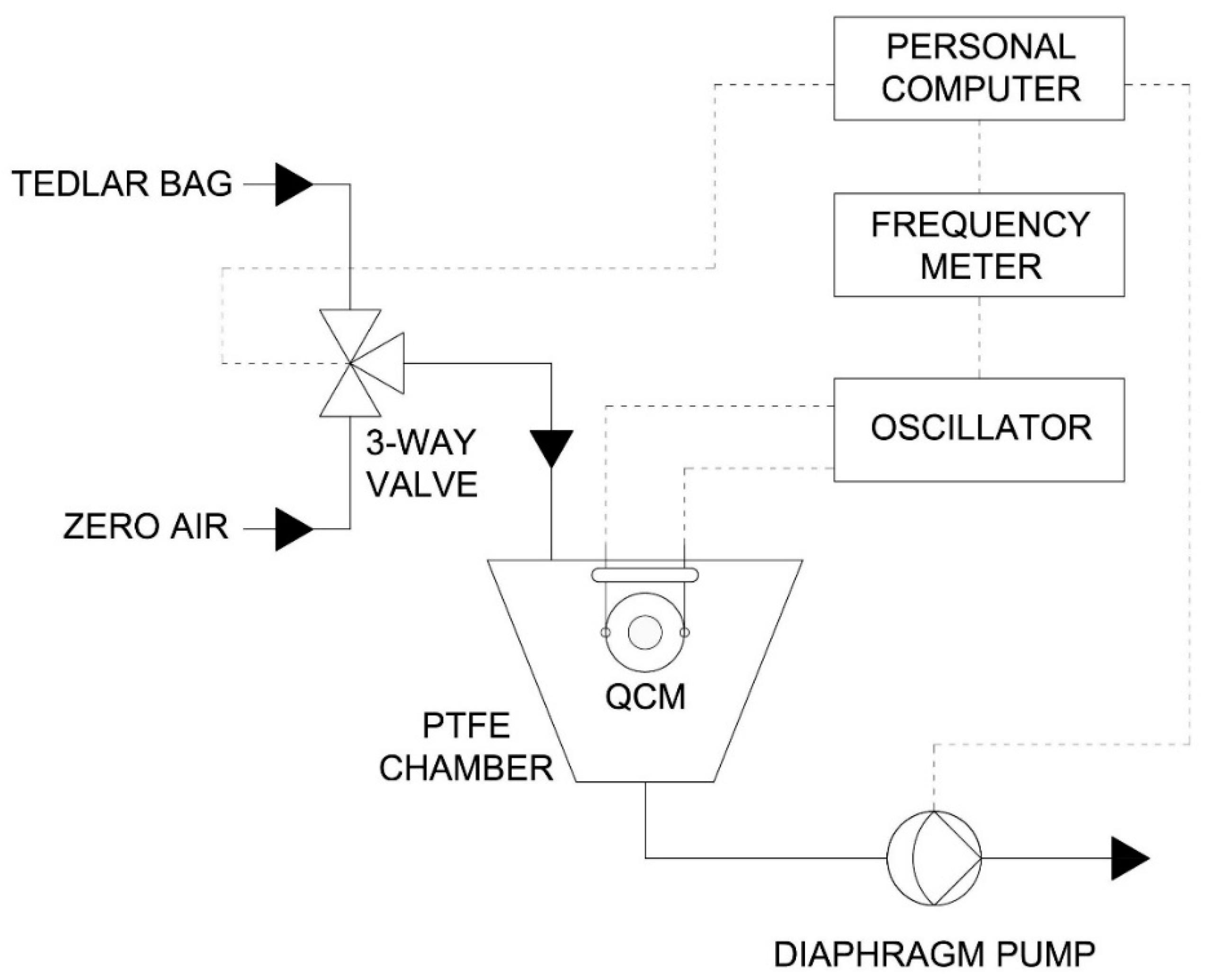
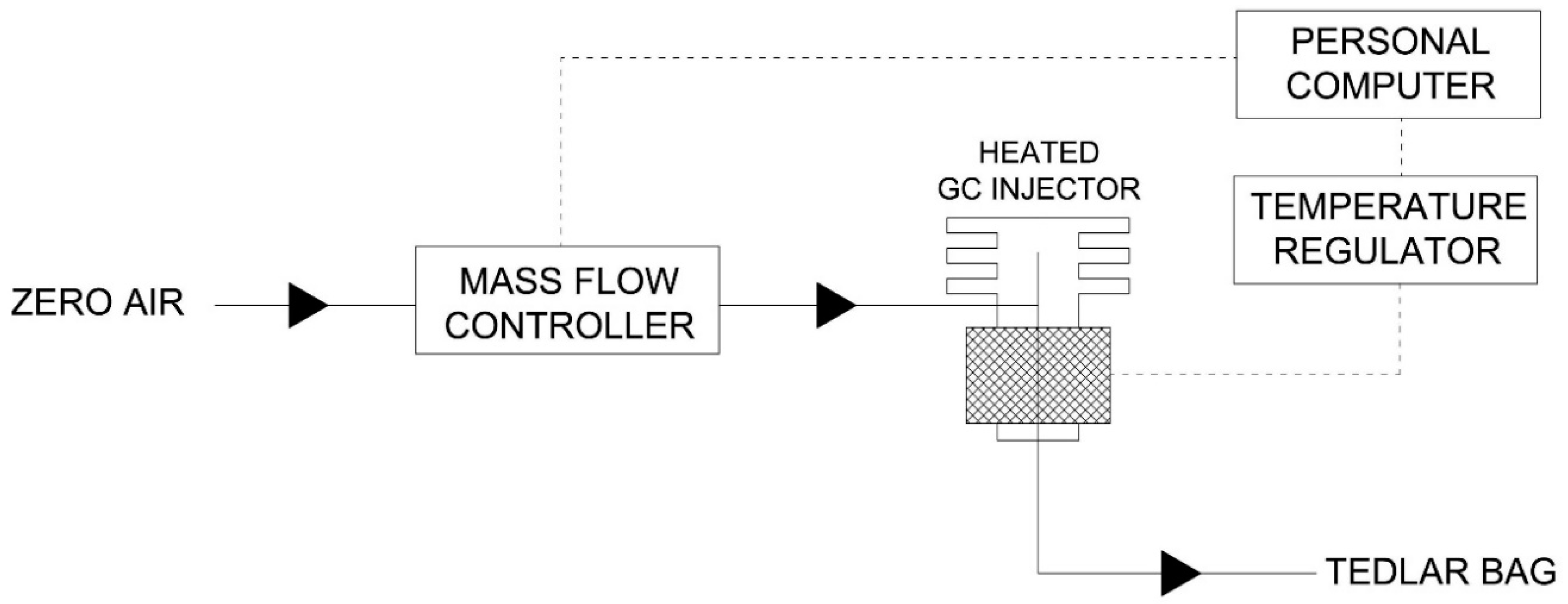
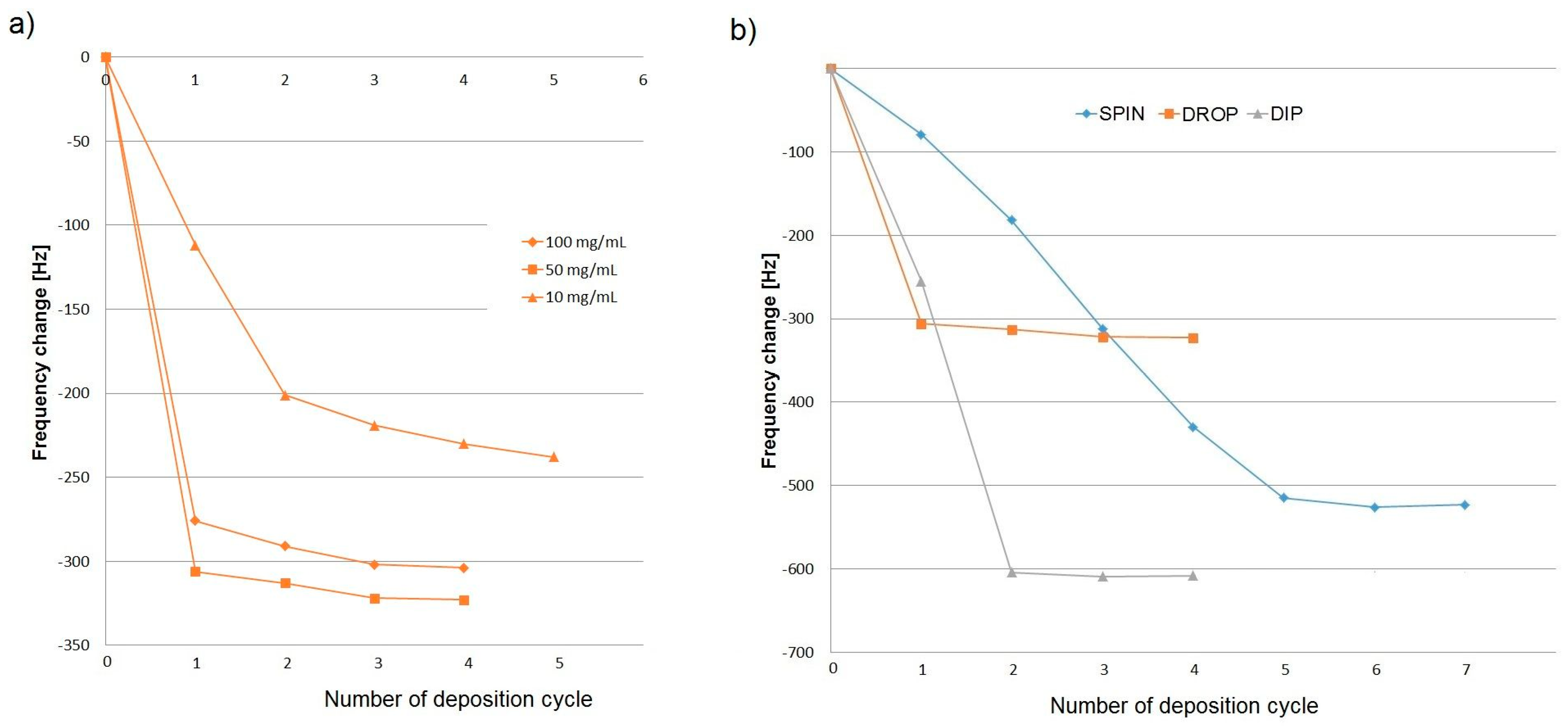
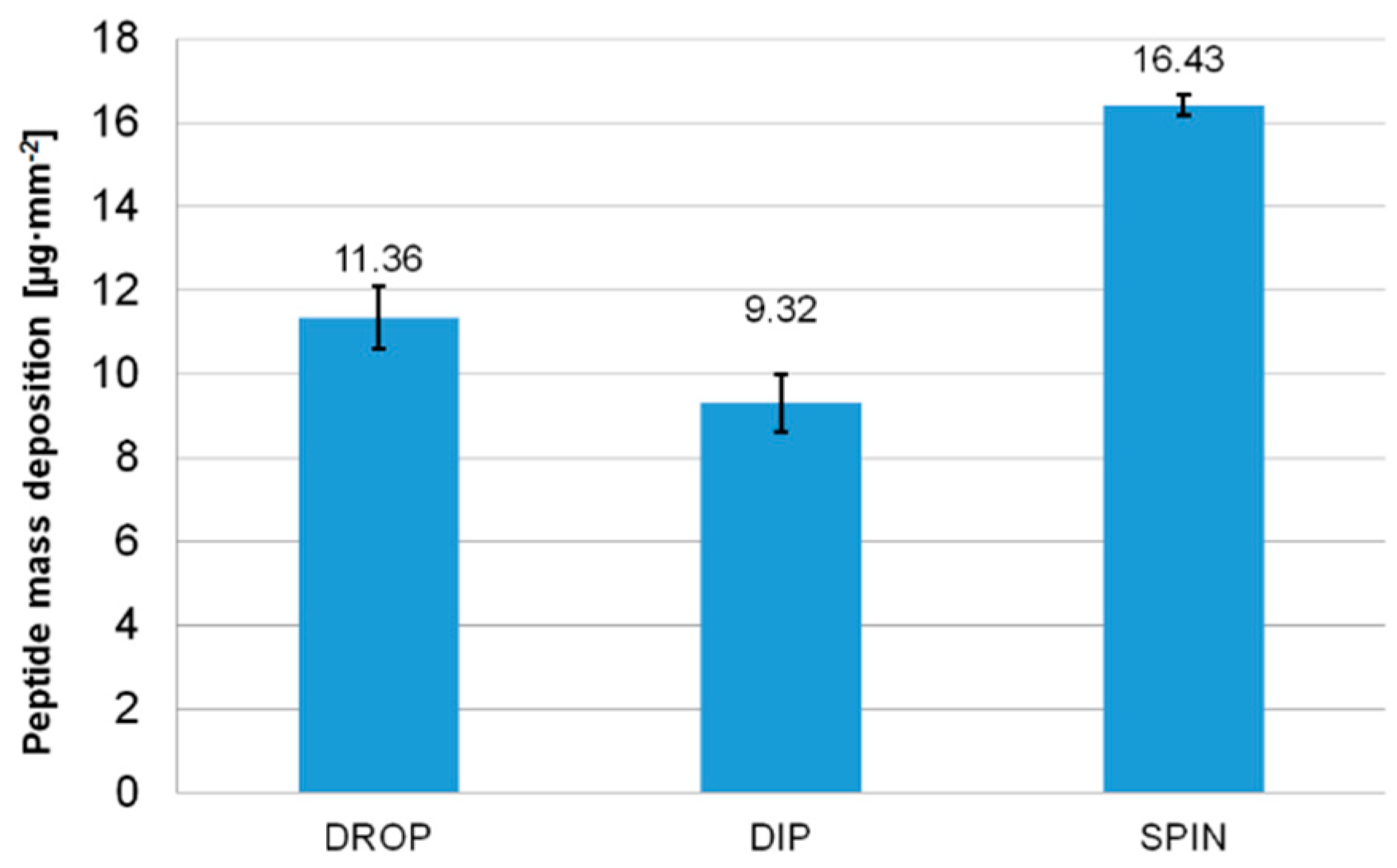
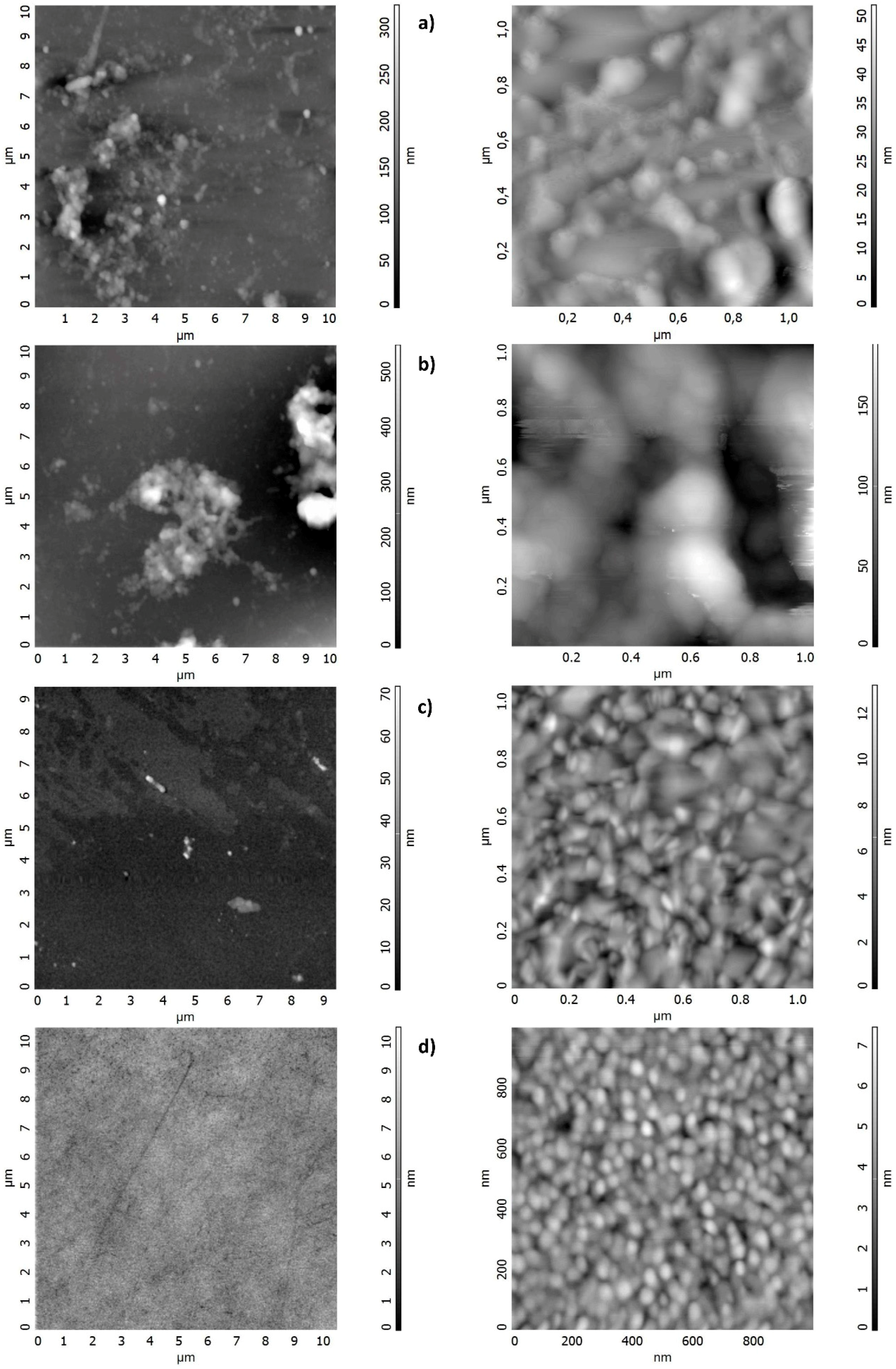
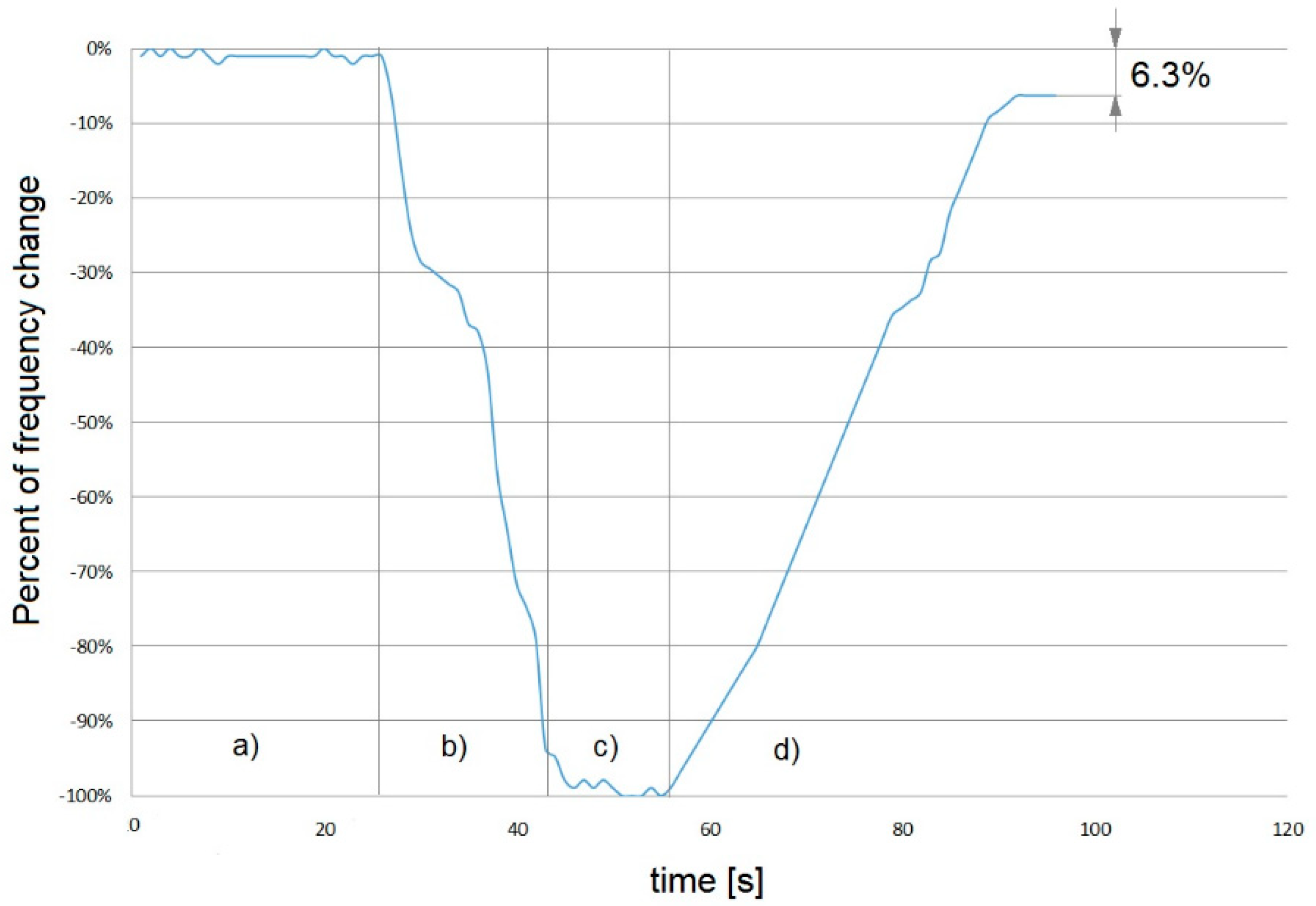
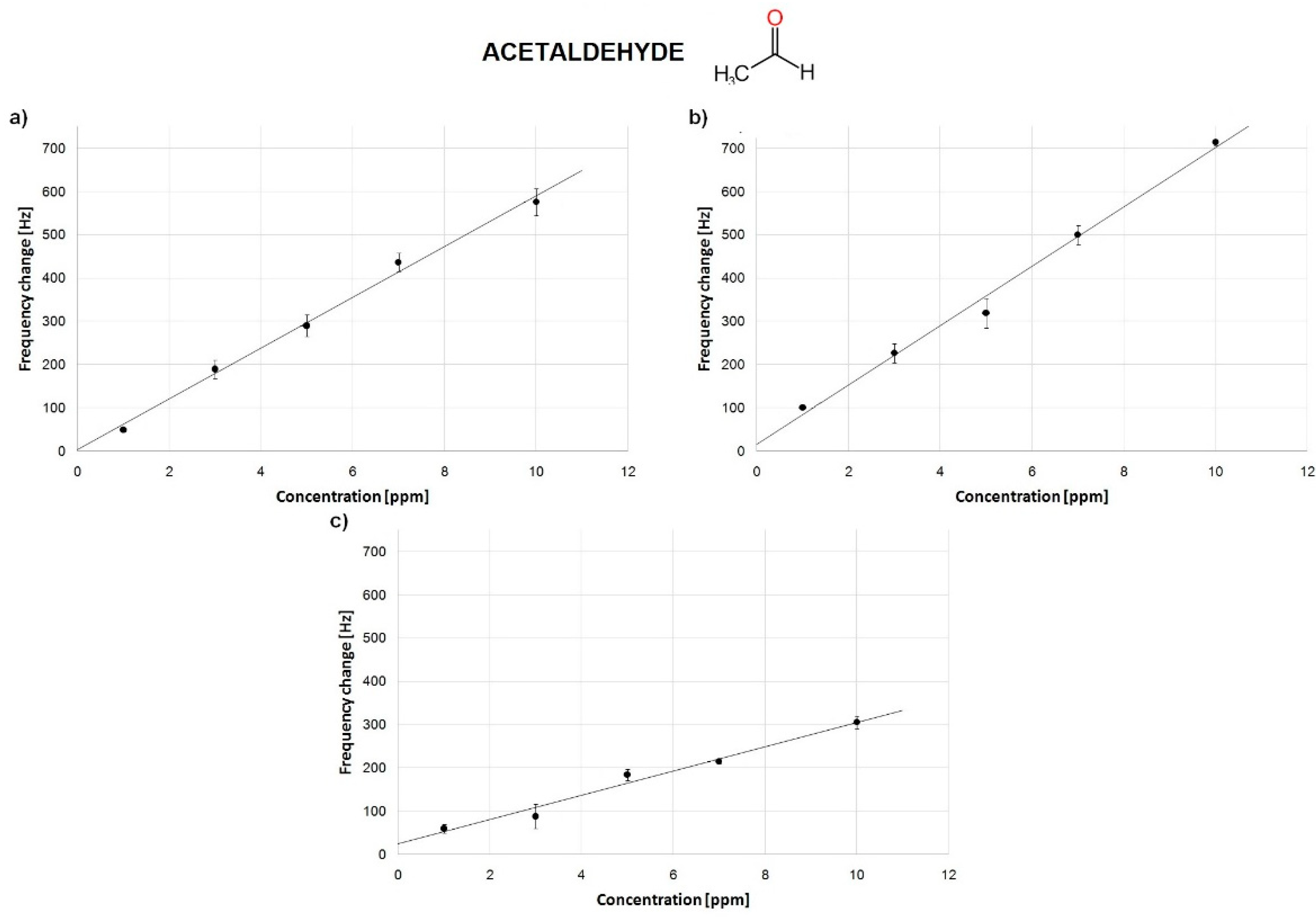
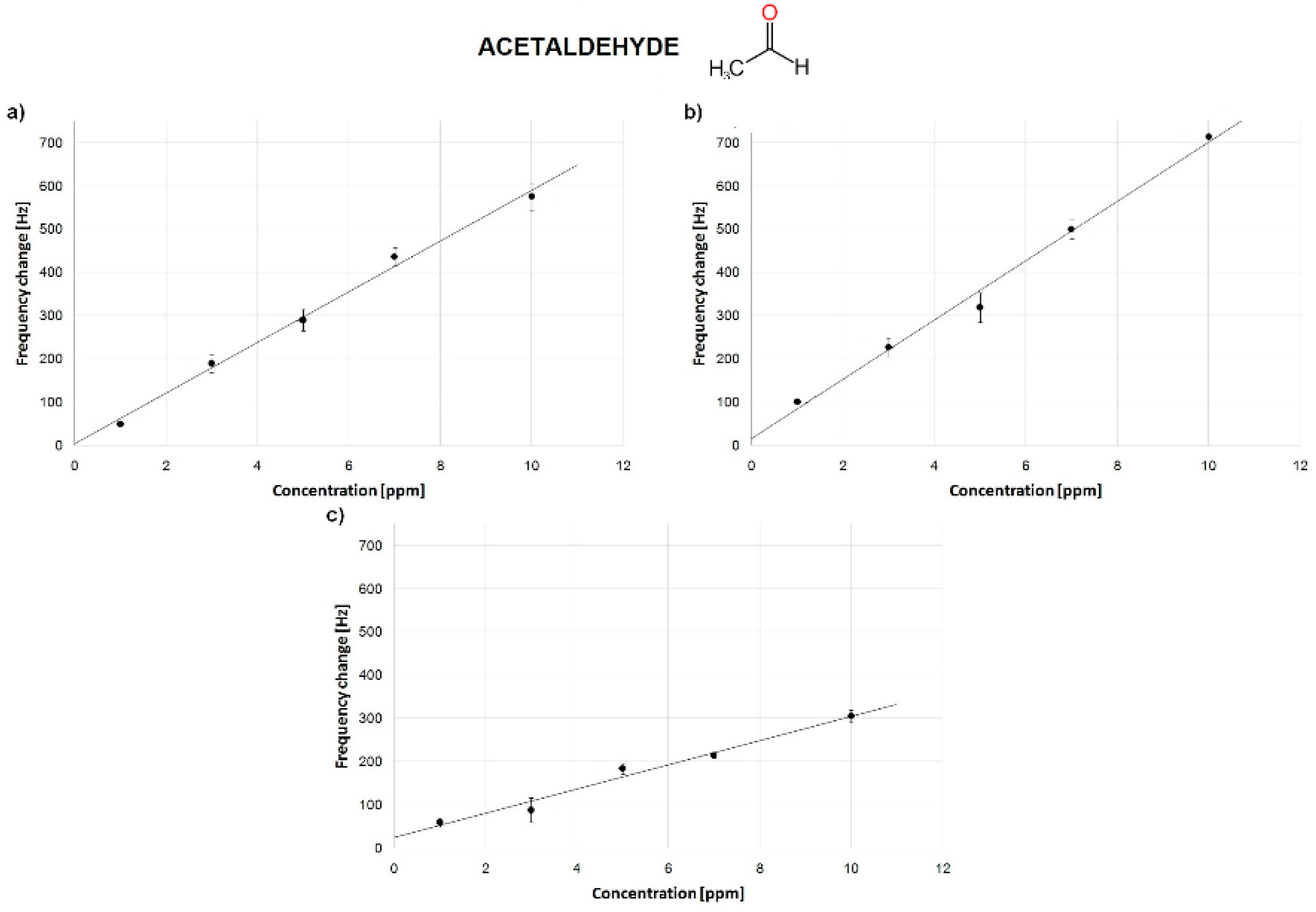
| Drop Casting | ||||||||
| Peptide Concentration | Peptide Volume For Cycle | Number of Drop Cycles | Deposition Time | |||||
| 10; 50; 100 mg/mL | 10 µL | 3–4 | 8 h | |||||
| Spin Coating | ||||||||
| Peptide Concentration | Peptide Volume For Cycle | Number of Spin Cycles | Spin Rate (Rpm) | Spin Acceleration (Rpm2) | Spin Time (S) | |||
| 50 mg/mL | 10 µL × 7 | 7 | 3000 | 100 | 10 × 30 | |||
| Dip Coating | ||||||||
| Peptide Concentration | Peptide Volume | Number of Dip Cycles | Dwell Time (S) | Immersion Rate (Mm/Min) | Withdraw Rate (Mm/Min) | Total Time | ||
| 50 mg/mL | 7 mL | 2–3 | 90 | 240 | 50 | 4 h | ||
| Technique | Advantage | Disadvantage |
|---|---|---|
| Drop casting |
|
|
| Dip coating |
|
|
| Spin coating |
|
|
| Deposition Method | Dip | Drop | Spin | |
|---|---|---|---|---|
| Mass deposition | 9.32 | 11.36 | 16.43 | |
| Acetaldehyde | R2 | 0.994 | 0.991 | 0.977 |
| Sensitivity (Hz·ppm−1) | 58.8 ± 2.8 | 68.5 ± 3.9 | 28.1 ± 2.6 | |
| LOD (ppm) | 1.0 | 1.2 | 2.0 | |
| Toluene | R2 | 0.980 | 0.984 | 0.987 |
| Sensitivity (Hz·ppm−1) | 6.13 ± 0.52 | 5.57 ± 0.49 | 3.10 ± 0.21 | |
| LOD (ppm) | 1.7 | 1.8 | 1.4 | |
| Deposition Method | Dip | Drop | Spin | ||||||
|---|---|---|---|---|---|---|---|---|---|
| Acetaldehyde concentration (ppm) | 1 | 5 | 10 | 1 | 5 | 10 | 1 | 5 | 10 |
| Frequency change mean value (Hz) | 49.3 | 287.8 | 579.6 | 96.4 | 316.3 | 712.7 | 60.3 | 181.4 | 298.7 |
| Standard deviation (Hz) | 2.1 | 7.1 | 6.9 | 6.4 | 11.7 | 18.1 | 4.8 | 12.5 | 14.1 |
| RSD (-) | 4.2% | 2.5% | 1.2% | 6.6% | 3.7% | 2.5% | 8.0% | 6.9% | 4.7% |
© 2018 by the authors. Licensee MDPI, Basel, Switzerland. This article is an open access article distributed under the terms and conditions of the Creative Commons Attribution (CC BY) license (http://creativecommons.org/licenses/by/4.0/).
Share and Cite
Wasilewski, T.; Szulczyński, B.; Kamysz, W.; Gębicki, J.; Namieśnik, J. Evaluation of Three Peptide Immobilization Techniques on a QCM Surface Related to Acetaldehyde Responses in the Gas Phase. Sensors 2018, 18, 3942. https://doi.org/10.3390/s18113942
Wasilewski T, Szulczyński B, Kamysz W, Gębicki J, Namieśnik J. Evaluation of Three Peptide Immobilization Techniques on a QCM Surface Related to Acetaldehyde Responses in the Gas Phase. Sensors. 2018; 18(11):3942. https://doi.org/10.3390/s18113942
Chicago/Turabian StyleWasilewski, Tomasz, Bartosz Szulczyński, Wojciech Kamysz, Jacek Gębicki, and Jacek Namieśnik. 2018. "Evaluation of Three Peptide Immobilization Techniques on a QCM Surface Related to Acetaldehyde Responses in the Gas Phase" Sensors 18, no. 11: 3942. https://doi.org/10.3390/s18113942
APA StyleWasilewski, T., Szulczyński, B., Kamysz, W., Gębicki, J., & Namieśnik, J. (2018). Evaluation of Three Peptide Immobilization Techniques on a QCM Surface Related to Acetaldehyde Responses in the Gas Phase. Sensors, 18(11), 3942. https://doi.org/10.3390/s18113942






